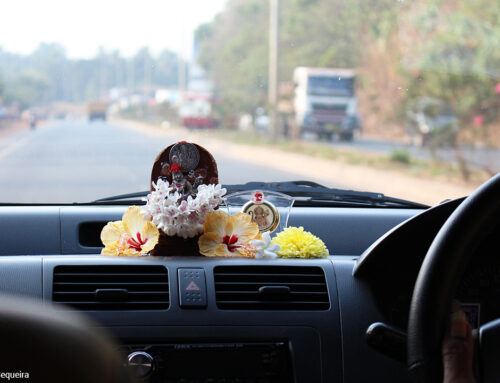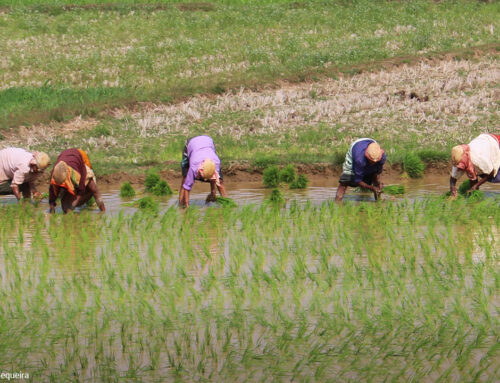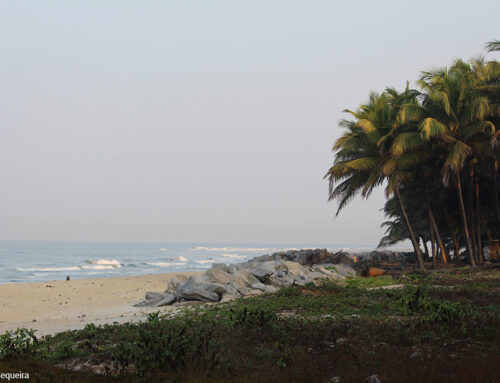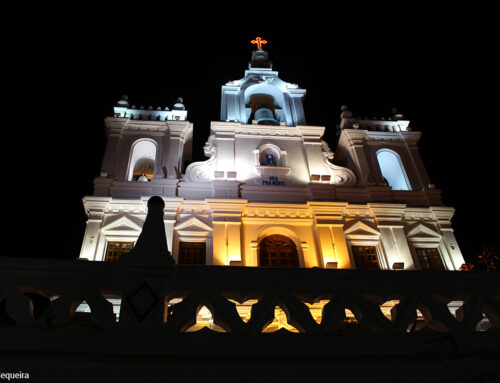This chapter is dedicated to the memory of my brother Milton Marques, who was also a seeker and an adventurer. He shared our journey through Ratnagiri, Malvan and Goa. His life was cut short, but our pursuit continues. He would have wanted it this way.
Almost everybody in Goa is aware that Karwar nestles quietly between the frenetic tourism of Goa and the hustle and bustle of larger towns like Udupi to the south. Yet, I had never cared to explore this town, located just 15 kms. south of Goa’s border with Karnataka. Even Rabindranath Tagore had made it there in 1882. Calling it the ‘Kashmir of Karnataka’, the Nobel laureate had dedicated a chapter to this town in his memoirs. So I was very excited to see Karwar, as Alan and I continued our journey through the Konkan coast. But wait. We weren’t prepared to leave Goa without one final fishy lunch. So we stopped at a shack for a fish curry and rice meal in Canacona – Goa’s frontier village – before we hit the border. The shack didn’t look so inviting, but the fish curry was, which the waiter was in no hurry to serve us.
With our bellies full of fish curry rice, we were now ready to tackle the cool, rarified air of the Sahayadri mountains, and the deepening twilight, as we climbed into the clouds towards our next stop in our pursuit of the perfect curry. Dappled and drowsy and ready to sleep, the 15 km drive through the verdant Sahyadri Mountains, was breathtakingly beautiful. The hairpin bends and sharp turns kept us alert, with sleep duly postponed.
And then Karwar slowly came into view, as it hugged the coast for dear life. It was breath-takingly beautiful. The green of the western ghat in the East made a stark contrast against the blue of the Arabian sea, creating the perfect palette. Nature seemed to have created this juxtaposition deliberately. After all, how good are palm trees, if you there’s no sea breeze to sway them? Karwar is predictably quaint, and lies at the mouth of the Kali river, blessed with a natural harbour, approximately 272 kilometres north of Karnataka’s chief port city Mangalore. The natural harbour makes it is the centre for a variety of businesses, especially agriculture, in addition to protecting it from the fury of the sea.
People in Karwar speak Konkani that is truly their own. And we had no problem asking around for a good hotel, and restaurant serving fresh seafood. Alan and I strolled around, checking out the sleepy town, with its basic shops and pristine beaches. Warmth and friendliness was never in short supply, as we meandered, asking questions, seeking help and waiting for the sun to go down so we could have dinner.
Every one we asked pointed us to Swetha Lunch home. Mr Shyamsunder Basroor, one of the owners of this veritable seafood paradise was happy to give us a tour of the kitchen. He emphasized that Swetha was not a restaurant, but a family-run place that served food you’d expect to eat at home. We saw several local women bustling about in the large, airy, open kitchen, helping prepare the different kinds of masalas on grinding stones. Their closely-guarded recipes have been in the family for generations and perhaps this unique feature has earned them TripAdvisor’s no. 1 ranking for seafood in Karwar. And for good reason. Every fish worth its name can be found on the menu: Shark, Kingfish, Lady Fish, Mackeral, Sardines, Squid, Teesryo (Clams), Crab, Kalwa (Rock Oysters) and something I had never seen on a menu before – ‘Poplet’ or Pomfret Biryani. Then there was ‘Jugalbandhi’ – Prawn and Chicken Biryani – Karwar’s own homage to Paella. We ordered fried, stuffed Pomfret, fish thali which included rice, fish curry, fish fry and one veggie dish (Rs. 60), and their house specialty – Teesra Wada. Crunchy and crisp Clam cutlets, deep fried in batter, that sent our tastebuds into a tizzy! It was the most awesome seafood fiesta we had yet encountered. Deliciously different and hugely satisfying. Check out for the Teesra Wada recipe in our Recipe Section.
We waddled out of Swetha Lunch home, safe in the knowledge that our unforgettable dinner at Swetha Lunch Home would be the highlight of our Karwar trip.
How wrong we were! There was more excitement in store for us – at Karwar Railway station, of all places. First, a happy encounter in the Ladies Waiting Room with the Goa Kabaddi team, which was on its way back after a tournament. This was surreal for me, because I had captained my school team which had won the inter school championship during my final year in high school! What a nice way to say goodbye to Karwar, I thought. And then it happened! While Alan went to get some water for the journey, an innocuous-looking young man who I had noticed observing me for a long time approached me and started chiding me for wearing pants which had the letter ‘Om’ printed on it. I’d worn those trousers all over India and had never given it a second thought! At first, it was a gentle scolding, telling me it was inappropriate for me to wear clothes with religious symbols. Soon, things took an ugly turn, and he grew more and more strident and started to recruit other travellers to join his tirade against me and my trousers. This was a public place and in India it takes no time for a crowd to gather in judgemental unity. Luckily, his urgent pleas fell on deaf ears because the Malayalee men he was trying to enlist, were having none of it. Not finding any takers, the man ultimately slunk away, and the thick tension from the air around me slowly dissipated. Because this was South India, a near-calamity was averted. Soon, this nasty glitch was put behind us, as the train forged ahead through a tunnel of verdant fields and bucolic forests. Chomping on ‘Goli Bajias’ and Banana Buns that filled Alan with nostalgia, and me with new tastes, we made our way to our next stop: Udupi. Home of Masala Dosa, Idli Sambhar, Medu Vada, Kori Rotti and more. The excitement of visiting a place, the name of which I had so far only seen on menus and store fronts, was beyond compare.
“Udupi, here we come, to taste the deliciousness of your long-held culinary traditions”, I thought, as we chugged further south into the warm embrace of Karnataka state. More of that in our next chapter. Stay tuned.
For photographs go to the Photo Gallery tab above; likewise for recipes.
Other places to visit in Karwar:
Beaches:
• Rabindranath Tagore
• Karwar
• Devbagh
• Tilimati
• Majali
• Binaga
• Koodi Bagh
Forts:
• Sadashivgad
Churches:
• St. Anne’s
Temples:
• Shejjeswar
• Durga
• Maruti
Other Attractions:
• Rock Stone Garden
• Anashi Waterfalls
• Oyster Rock Lighthouse
• Kali River Garden
• Karumgad Island
• Celestial Flights
• Guddali Park
• Ullavi Caves
Best time to visit: November – March
Know your Konkan Coast

The Konkan coast runs south from Mumbai all the way to Kasargod. Quaint fishing villages and magnificent forts look out into the endless blue of the Arabian sea. Pristine beaches and coconut palm trees dot the coast all along, until you reach Malvan, the last beach town of significance, before the sands dissolve into Goa. The cuisine along the Konkan coast is as varied as it is delicious, greatly influenced by its geographic location, and layered history of the region. They are all intertwined yet distinct. Some patterns are common – like the seasons which influenced bottling pickles, and drying of fish and pork etc. The monsoon brought a lot of seasonal foods like bamboo, snails (conge) etc to the table. Coconut is an integral part of the Konkan cuisine. Apart from local influences, Portuguese and Arab influences had major impacts.









“Sapere aude.”
A popular Latin school motto, this one means, “Dare to know.” It’s commonly associated with the Age of Enlightenment and may be the reminder you need to never stop learning, no matter your age. Waiting for your next blog to learn more and more.
Thank you for your comment, Gautam. Let’s always ‘Sapere aude’.
As always a real pleasure to read your articles Milena. Its like almost I’m there experiencing it first hand. Thank you.
I have never visited Karwar either, Milena. Thank you for adding to our bucket list on our next trip to India. Looking forward to reading your next mouthwatering blog.
A sad occasion I must say regarding your brother but glad you are able to remember him by fond memories – those are truly the gems we all can leave behind! Thanks for sharing Milena!
Very articulate article. Useful tip for travellers who seek nature and a taste of authentic Konkan cuisine and also gives you details of what to expect and venture into.
Well done Milena. Keep writing this good stuff it enlightens me and many others too.
Thanks